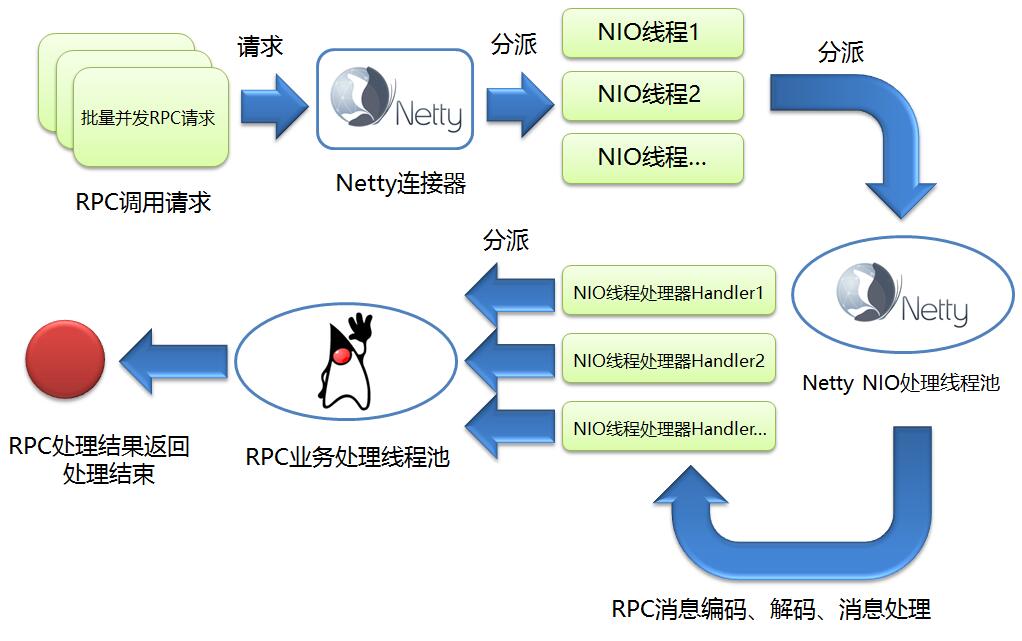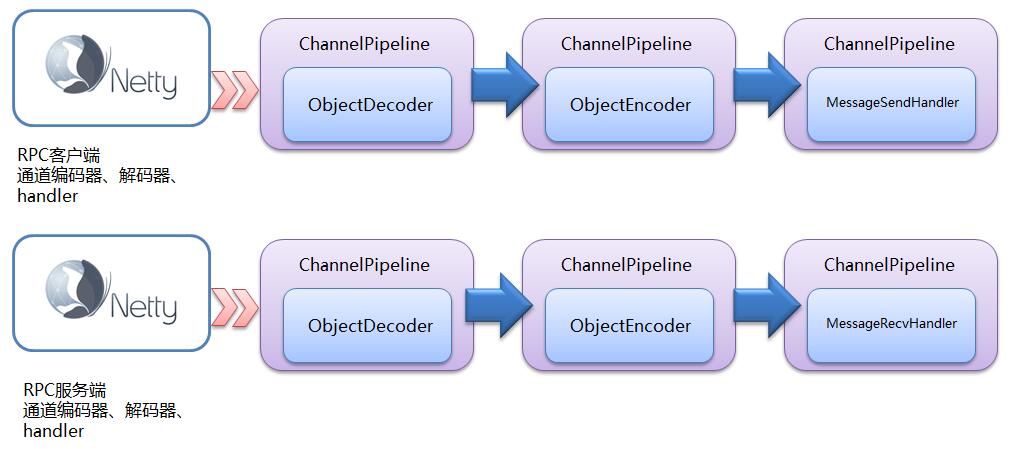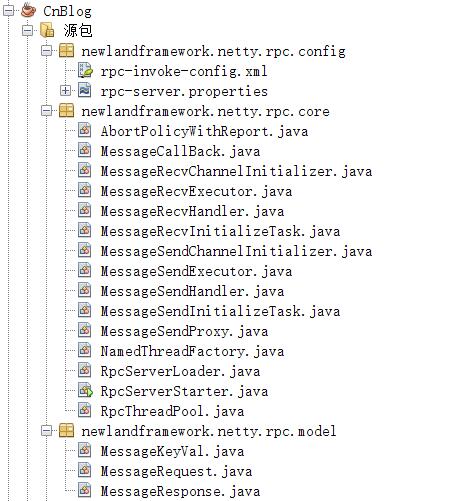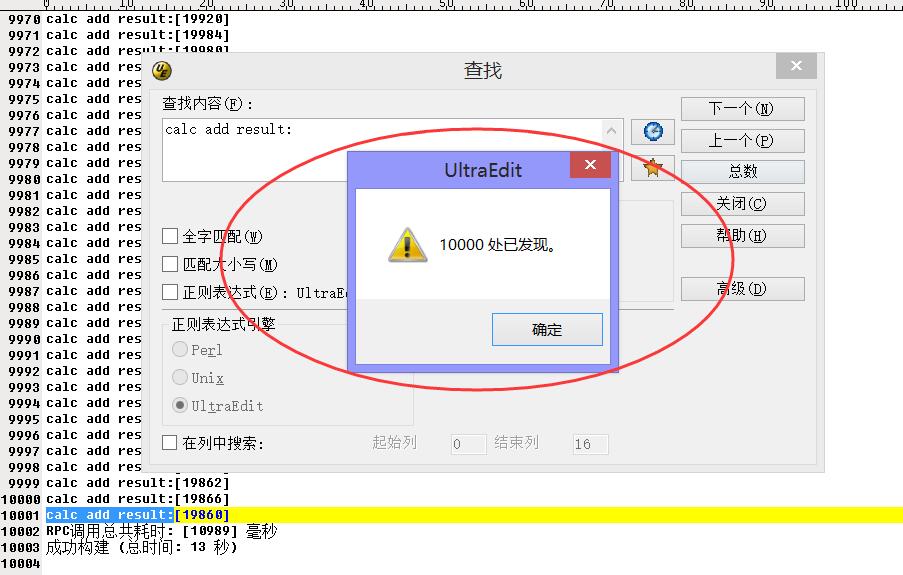RPC(Remote Procedure Call Protocol)远程过程调用协议,它是一种通过网络,从远程计算机程序上请求服务,而不必了解底层网络技术的协议。说的再直白一点,就是客户端在不必知道调用细节的前提之下,调用远程计算机上运行的某个对象,使用起来就像调用本地的对象一样。目前典型的RPC实现框架有:Thrift(facebook开源)、Dubbo(alibaba开源)等等。RPC框架针对网络协议、网络I/O模型的封装是透明的,对于调用的客户端而言,它就认为自己在调用本地的一个对象。至于传输层上,运用的是TCP协议、UDP协议、亦或是HTTP协议,一概不关心。从网络I/O模型上来看,是基于select、poll、epoll方式、还是IOCP(I/O Completion Port)方式承载实现的,对于调用者而言也不用关心。
目前,主流的RPC框架都支持跨语言调用,即有所谓的IDL(接口定义语言),其实,这个并不是RPC所必须要求的。如果你的RPC框架没有跨语言的要求,IDL就可以不用包括了。
最后,值得一提的是,衡量一个RPC框架性能的好坏与否,RPC的网络I/O模型的选择,至关重要。在此基础上,设计出来的RPC服务器,可以考虑支持阻塞式同步IO、非阻塞式同步IO、当然还有所谓的多路复用IO模型、异步IO模型。支持不同的网络IO模型,在高并发的状态下,处理性能上会有很大的差别。还有一个衡量的标准,就是选择的传输协议。是基于TCP协议、还是HTTP协议、还是UDP协议?对性能也有一定的影响。但是从我目前了解的情况来看,大多数RPC开源实现框架都是基于TCP、或者HTTP的,目测没有采用UDP协议做为主要的传输协议的。
明白了RPC的使用原理和性能要求。现在,我们能不能撇开那些RPC开源框架,自己动手开发一个高性能的RPC服务器呢?我想,还是可以的。现在本人就使用Java,基于Netty,开发实现一个高性能的RPC服务器。
如何实现、基于什么原理?并发处理性能如何?请继续接着看下文。
我们有的时候,为了提高单个节点的通信吞吐量,提高通信性能。如果是基于Java后端的,一般首选的是NIO框架(No-block IO)。但是问题也来了,Java的NIO掌握起来要相当的技术功底,和足够的技术积累,使用起来才能得心应手。一般的开发人员,如果要使用NIO开发一个后端的TCP/HTTP服务器,附带考虑TCP粘包、网络通信异常、消息链接处理等等网络通信细节,开发门槛太高,所以比较明智的选择是,采用业界主流的NIO框架进行服务器后端开发。主流的NIO框架主要有Netty、Mina。它们主要都是基于TCP通信,非阻塞的IO、灵活的IO线程池而设计的,应对高并发请求也是绰绰有余。随着Netty、Mina这样优秀的NIO框架,设计上日趋完善,Java后端高性能服务器开发,在技术上提供了有力的支持保障,从而打破了C++在服务器后端,一统天下的局面。因为在此之前,Java的NIO一直受人诟病,让人敬而远之!
既然,这个RPC服务器是基于Netty的,那就在说说Netty吧。实际上Netty是对JAVA NIO框架的再次封装,它的开源网址是http://netty.io/,本文中使用的Netty版本是:4.0版本,可以通过http://dl.bintray.com/netty/downloads/netty-4.0.37.Final.tar.bz2,进行下载使用。那也许你会问,如何使用Netty进行RPC服务器的开发呢?实际不难,下面我就简单的说明一下技术原理:
1、定义RPC请求消息、应答消息结构,里面要包括RPC的接口定义模块、包括远程调用的类名、方法名称、参数结构、参数值等信息。
2、服务端初始化的时候通过容器加载RPC接口定义和RPC接口实现类对象的映射关系,然后等待客户端发起调用请求。
3、客户端发起的RPC消息里面包含,远程调用的类名、方法名称、参数结构、参数值等信息,通过网络,以字节流的方式送给RPC服务端,RPC服务端接收到字节流的请求之后,去对应的容器里面,查找客户端接口映射的具体实现对象。
4、RPC服务端找到实现对象的参数信息,通过反射机制创建该对象的实例,并返回调用处理结果,最后封装成RPC应答消息通知到客户端。
5、客户端通过网络,收到字节流形式的RPC应答消息,进行拆包、解析之后,显示远程调用结果。
上面说的是很简单,但是实现的时候,我们还要考虑如下的问题:
1、RPC服务器的传输层是基于TCP协议的,出现粘包咋办?这样客户端的请求,服务端不是会解析失败?好在Netty里面已经提供了解决TCP粘包问题的解码器:LengthFieldBasedFrameDecoder,可以靠它轻松搞定TCP粘包问题。
2、Netty服务端的线程模型是单线程、多线程(一个线程负责客户端连接,连接成功之后,丢给后端IO的线程池处理)、还是主从模式(客户端连接、后端IO处理都是基于线程池的实现)。当然在这里,我出于性能考虑,使用了Netty主从线程池模型。
3、Netty的IO处理线程池,如果遇到非常耗时的业务,出现阻塞了咋办?这样不是很容易把后端的NIO线程给挂死、阻塞?本文的处理方式是,对于复杂的后端业务,分派到专门的业务线程池里面,进行异步回调处理。
4、RPC消息的传输是通过字节流在NIO的通道(Channel)之间传输,那具体如何实现呢?本文,是通过基于Java原生对象序列化机制的编码、解码器(ObjectEncoder、ObjectDecoder)进行实现的。当然出于性能考虑,这个可能不是最优的方案。更优的方案是把消息的编码、解码器,搞成可以配置实现的。具体比如可以通过:protobuf、JBoss Marshalling方式进行解码和编码,以提高网络消息的传输效率。
5、RPC服务器要考虑多线程、高并发的使用场景,所以线程安全是必须的。此外尽量不要使用synchronized进行加锁,改用轻量级的ReentrantLock方式进行代码块的条件加锁。比如本文中的RPC消息处理回调,就有这方面的使用。
6、RPC服务端的服务接口对象和服务接口实现对象要能轻易的配置,轻松进行加载、卸载。在这里,本文是通过Spring容器进行统一的对象管理。
综上所述,本文设计的RPC服务器调用的流程图如下所示:

客户端并发发起RPC调用请求,然后RPC服务端使用Netty连接器,分派出N个NIO连接线程,这个时候Netty连接器的任务结束。然后NIO连接线程是统一放到Netty NIO处理线程池进行管理,这个线程池里面会对具体的RPC请求连接进行消息编码、消息解码、消息处理等等一系列操作。最后进行消息处理(Handler)的时候,处于性能考虑,这里的设计是,直接把复杂的消息处理过程,丢给专门的RPC业务处理线程池集中处理,然后Handler对应的NIO线程就立即返回、不会阻塞。这个时候RPC调用结束,客户端会异步等待服务端消息的处理结果,本文是通过消息回调机制实现(MessageCallBack)。
再来说一说Netty对于RPC消息的解码、编码、处理对应的模块和流程,具体如下图所示:

从上图可以看出客户端、服务端对RPC消息编码、解码、处理调用的模块以及调用顺序了。Netty就是把这样一个一个的处理器串在一起,形成一个责任链,统一进行调用。
说了这么多,现在先简单看下,我设计实现的NettyRPC的代码目录层级结构:

其中newlandframework.netty.rpc.core包是NettyRPC的核心实现。newlandframework.netty.rpc.model包里面,则封装了RPC消息请求、应答报文结构,以及RPC服务接口与实现绑定关系的容器定义。newlandframework.netty.rpc.config里面定义了NettyRPC的服务端文件配置属性。
下面先来看下newlandframework.netty.rpc.model包中定义的内容。具体是RPC消息请求、应答消息的结构定义:
RPC请求消息结构- /**
- * @filename:MessageRequest.java
- *
- * Newland Co. Ltd. All rights reserved.
- *
- * @Description:rpc服务请求结构
- * @author tangjie
- * @version 1.0
- *
- */
- package newlandframework.netty.rpc.model;
- import java.io.Serializable;
- import org.apache.commons.lang.builder.ToStringBuilder;
- import org.apache.commons.lang.builder.ToStringStyle;
- public class MessageRequest implements Serializable {
- private String messageId;
- private String className;
- private String methodName;
- private Class<?>[] typeParameters;
- private Object[] parametersVal;
- public String getMessageId() {
- return messageId;
- }
- public void setMessageId(String messageId) {
- this.messageId = messageId;
- }
- public String getClassName() {
- return className;
- }
- public void setClassName(String className) {
- this.className = className;
- }
- public String getMethodName() {
- return methodName;
- }
- public void setMethodName(String methodName) {
- this.methodName = methodName;
- }
- public Class<?>[] getTypeParameters() {
- return typeParameters;
- }
- public void setTypeParameters(Class<?>[] typeParameters) {
- this.typeParameters = typeParameters;
- }
- public Object[] getParameters() {
- return parametersVal;
- }
- public void setParameters(Object[] parametersVal) {
- this.parametersVal = parametersVal;
- }
- public String toString() {
- return new ToStringBuilder(this, ToStringStyle.SHORT_PREFIX_STYLE)
- .append("messageId", messageId).append("className", className)
- .append("methodName", methodName).toString();
- }
- }
- /**
- * @filename:MessageResponse.java
- *
- * Newland Co. Ltd. All rights reserved.
- *
- * @Description:rpc服务应答结构
- * @author tangjie
- * @version 1.0
- *
- */
- package newlandframework.netty.rpc.model;
- import java.io.Serializable;
- import org.apache.commons.lang.builder.ToStringBuilder;
- import org.apache.commons.lang.builder.ToStringStyle;
- public class MessageResponse implements Serializable {
- private String messageId;
- private String error;
- private Object resultDesc;
- public String getMessageId() {
- return messageId;
- }
- public void setMessageId(String messageId) {
- this.messageId = messageId;
- }
- public String getError() {
- return error;
- }
- public void setError(String error) {
- this.error = error;
- }
- public Object getResult() {
- return resultDesc;
- }
- public void setResult(Object resultDesc) {
- this.resultDesc = resultDesc;
- }
- public String toString() {
- return new ToStringBuilder(this, ToStringStyle.SHORT_PREFIX_STYLE)
- .append("messageId", messageId).append("error", error).toString();
- }
- }
- /**
- * @filename:MessageKeyVal.java
- *
- * Newland Co. Ltd. All rights reserved.
- *
- * @Description:rpc服务映射容器
- * @author tangjie
- * @version 1.0
- *
- */
- package newlandframework.netty.rpc.model;
- import java.util.Map;
- public class MessageKeyVal {
- private Map<String, Object> messageKeyVal;
- public void setMessageKeyVal(Map<String, Object> messageKeyVal) {
- this.messageKeyVal = messageKeyVal;
- }
- public Map<String, Object> getMessageKeyVal() {
- return messageKeyVal;
- }
- }
线程工厂定义实现- /**
- * @filename:NamedThreadFactory.java
- *
- * Newland Co. Ltd. All rights reserved.
- *
- * @Description:线程工厂
- * @author tangjie
- * @version 1.0
- *
- */
- package newlandframework.netty.rpc.core;
- import java.util.concurrent.ThreadFactory;
- import java.util.concurrent.atomic.AtomicInteger;
- public class NamedThreadFactory implements ThreadFactory {
- private static final AtomicInteger threadNumber = new AtomicInteger(1);
- private final AtomicInteger mThreadNum = new AtomicInteger(1);
- private final String prefix;
- private final boolean daemoThread;
- private final ThreadGroup threadGroup;
- public NamedThreadFactory() {
- this("rpcserver-threadpool-" + threadNumber.getAndIncrement(), false);
- }
- public NamedThreadFactory(String prefix) {
- this(prefix, false);
- }
- public NamedThreadFactory(String prefix, boolean daemo) {
- this.prefix = prefix + "-thread-";
- daemoThread = daemo;
- SecurityManager s = System.getSecurityManager();
- threadGroup = (s == null) ? Thread.currentThread().getThreadGroup() : s.getThreadGroup();
- }
- public Thread newThread(Runnable runnable) {
- String name = prefix + mThreadNum.getAndIncrement();
- Thread ret = new Thread(threadGroup, runnable, name, 0);
- ret.setDaemon(daemoThread);
- return ret;
- }
- public ThreadGroup getThreadGroup() {
- return threadGroup;
- }
- }
- /**
- * @filename:RpcThreadPool.java
- *
- * Newland Co. Ltd. All rights reserved.
- *
- * @Description:rpc线程池封装
- * @author tangjie
- * @version 1.0
- *
- */
- package newlandframework.netty.rpc.core;
- import java.util.concurrent.Executor;
- import java.util.concurrent.LinkedBlockingQueue;
- import java.util.concurrent.SynchronousQueue;
- import java.util.concurrent.ThreadPoolExecutor;
- import java.util.concurrent.TimeUnit;
- public class RpcThreadPool {
- //独立出线程池主要是为了应对复杂耗I/O操作的业务,不阻塞netty的handler线程而引入
- //当然如果业务足够简单,把处理逻辑写入netty的handler(ChannelInboundHandlerAdapter)也未尝不可
- public static Executor getExecutor(int threads, int queues) {
- String name = "RpcThreadPool";
- return new ThreadPoolExecutor(threads, threads, 0, TimeUnit.MILLISECONDS,
- queues == 0 ? new SynchronousQueue<Runnable>()
- : (queues < 0 ? new LinkedBlockingQueue<Runnable>()
- : new LinkedBlockingQueue<Runnable>(queues)),
- new NamedThreadFactory(name, true), new AbortPolicyWithReport(name));
- }
- }
- /**
- * @filename:AbortPolicyWithReport.java
- *
- * Newland Co. Ltd. All rights reserved.
- *
- * @Description:线程池异常策略
- * @author tangjie
- * @version 1.0
- *
- */
- package newlandframework.netty.rpc.core;
- import java.util.concurrent.RejectedExecutionException;
- import java.util.concurrent.ThreadPoolExecutor;
- public class AbortPolicyWithReport extends ThreadPoolExecutor.AbortPolicy {
- private final String threadName;
- public AbortPolicyWithReport(String threadName) {
- this.threadName = threadName;
- }
- public void rejectedExecution(Runnable r, ThreadPoolExecutor e) {
- String msg = String.format("RpcServer["
- + " Thread Name: %s, Pool Size: %d (active: %d, core: %d, max: %d, largest: %d), Task: %d (completed: %d),"
- + " Executor status:(isShutdown:%s, isTerminated:%s, isTerminating:%s)]",
- threadName, e.getPoolSize(), e.getActiveCount(), e.getCorePoolSize(), e.getMaximumPoolSize(), e.getLargestPoolSize(),
- e.getTaskCount(), e.getCompletedTaskCount(), e.isShutdown(), e.isTerminated(), e.isTerminating());
- System.out.println(msg);
- throw new RejectedExecutionException(msg);
- }
- }
- /**
- * @filename:MessageSendExecutor.java
- *
- * Newland Co. Ltd. All rights reserved.
- *
- * @Description:Rpc客户端执行模块
- * @author tangjie
- * @version 1.0
- *
- */
- package newlandframework.netty.rpc.core;
- import java.lang.reflect.Proxy;
- public class MessageSendExecutor {
- private RpcServerLoader loader = RpcServerLoader.getInstance();
- public MessageSendExecutor(String serverAddress) {
- loader.load(serverAddress);
- }
- public void stop() {
- loader.unLoad();
- }
- public static <T> T execute(Class<T> rpcInterface) {
- return (T) Proxy.newProxyInstance(
- rpcInterface.getClassLoader(),
- new Class<?>[]{rpcInterface},
- new MessageSendProxy<T>(rpcInterface)
- );
- }
- }
- /**
- * @filename:MessageSendProxy.java
- *
- * Newland Co. Ltd. All rights reserved.
- *
- * @Description:Rpc客户端消息处理
- * @author tangjie
- * @version 1.0
- *
- */
- package newlandframework.netty.rpc.core;
- import java.lang.reflect.InvocationHandler;
- import java.lang.reflect.Method;
- import java.util.UUID;
- import newlandframework.netty.rpc.model.MessageRequest;
- public class MessageSendProxy<T> implements InvocationHandler {
- private Class<T> cls;
- public MessageSendProxy(Class<T> cls) {
- this.cls = cls;
- }
- public Object invoke(Object proxy, Method method, Object[] args) throws Throwable {
- MessageRequest request = new MessageRequest();
- request.setMessageId(UUID.randomUUID().toString());
- request.setClassName(method.getDeclaringClass().getName());
- request.setMethodName(method.getName());
- request.setTypeParameters(method.getParameterTypes());
- request.setParameters(args);
- MessageSendHandler handler = RpcServerLoader.getInstance().getMessageSendHandler();
- MessageCallBack callBack = handler.sendRequest(request);
- return callBack.start();
- }
- }
- /**
- * @filename:RpcServerLoader.java
- *
- * Newland Co. Ltd. All rights reserved.
- *
- * @Description:rpc服务器配置加载
- * @author tangjie
- * @version 1.0
- *
- */
- package newlandframework.netty.rpc.core;
- import io.netty.channel.EventLoopGroup;
- import io.netty.channel.nio.NioEventLoopGroup;
- import java.net.InetSocketAddress;
- import java.util.concurrent.ThreadPoolExecutor;
- import java.util.concurrent.locks.Condition;
- import java.util.concurrent.locks.Lock;
- import java.util.concurrent.locks.ReentrantLock;
- import newlandframework.netty.rpc.serialize.support.RpcSerializeProtocol;
- public class RpcServerLoader {
- private volatile static RpcServerLoader rpcServerLoader;
- private final static String DELIMITER = ":";
- private RpcSerializeProtocol serializeProtocol = RpcSerializeProtocol.JDKSERIALIZE;
- //方法返回到Java虚拟机的可用的处理器数量
- private final static int parallel = Runtime.getRuntime().availableProcessors() * 2;
- //netty nio线程池
- private EventLoopGroup eventLoopGroup = new NioEventLoopGroup(parallel);
- private static ThreadPoolExecutor threadPoolExecutor = (ThreadPoolExecutor) RpcThreadPool.getExecutor(16, -1);
- private MessageSendHandler messageSendHandler = null;
- //等待Netty服务端链路建立通知信号
- private Lock lock = new ReentrantLock();
- private Condition signal = lock.newCondition();
- private RpcServerLoader() {
- }
- //并发双重锁定
- public static RpcServerLoader getInstance() {
- if (rpcServerLoader == null) {
- synchronized (RpcServerLoader.class) {
- if (rpcServerLoader == null) {
- rpcServerLoader = new RpcServerLoader();
- }
- }
- }
- return rpcServerLoader;
- }
- public void load(String serverAddress, RpcSerializeProtocol serializeProtocol) {
- String[] ipAddr = serverAddress.split(RpcServerLoader.DELIMITER);
- if (ipAddr.length == 2) {
- String host = ipAddr[0];
- int port = Integer.parseInt(ipAddr[1]);
- final InetSocketAddress remoteAddr = new InetSocketAddress(host, port);
- threadPoolExecutor.submit(new MessageSendInitializeTask(eventLoopGroup, remoteAddr, this, serializeProtocol));
- }
- }
- public void setMessageSendHandler(MessageSendHandler messageInHandler) {
- try {
- lock.lock();
- this.messageSendHandler = messageInHandler;
- //唤醒所有等待客户端RPC线程
- signal.signalAll();
- } finally {
- lock.unlock();
- }
- }
- public MessageSendHandler getMessageSendHandler() throws InterruptedException {
- try {
- lock.lock();
- //Netty服务端链路没有建立完毕之前,先挂起等待
- if (messageSendHandler == null) {
- signal.await();
- }
- return messageSendHandler;
- } finally {
- lock.unlock();
- }
- }
- public void unLoad() {
- messageSendHandler.close();
- threadPoolExecutor.shutdown();
- eventLoopGroup.shutdownGracefully();
- }
- public void setSerializeProtocol(RpcSerializeProtocol serializeProtocol) {
- this.serializeProtocol = serializeProtocol;
- }
- }
- /**
- * @filename:MessageSendInitializeTask.java
- *
- * Newland Co. Ltd. All rights reserved.
- *
- * @Description:Rpc客户端线程任务处理
- * @author tangjie
- * @version 1.0
- *
- */
- package newlandframework.netty.rpc.core;
- import io.netty.bootstrap.Bootstrap;
- import io.netty.channel.ChannelFuture;
- import io.netty.channel.ChannelFutureListener;
- import io.netty.channel.ChannelOption;
- import io.netty.channel.EventLoopGroup;
- import io.netty.channel.socket.nio.NioSocketChannel;
- import java.net.InetSocketAddress;
- public class MessageSendInitializeTask implements Runnable {
- private EventLoopGroup eventLoopGroup = null;
- private InetSocketAddress serverAddress = null;
- private RpcServerLoader loader = null;
- MessageSendInitializeTask(EventLoopGroup eventLoopGroup, InetSocketAddress serverAddress, RpcServerLoader loader) {
- this.eventLoopGroup = eventLoopGroup;
- this.serverAddress = serverAddress;
- this.loader = loader;
- }
- public void run() {
- Bootstrap b = new Bootstrap();
- b.group(eventLoopGroup)
- .channel(NioSocketChannel.class).option(ChannelOption.SO_KEEPALIVE, true);
- b.handler(new MessageSendChannelInitializer());
- ChannelFuture channelFuture = b.connect(serverAddress);
- channelFuture.addListener(new ChannelFutureListener() {
- public void operationComplete(final ChannelFuture channelFuture) throws Exception {
- if (channelFuture.isSuccess()) {
- MessageSendHandler handler = channelFuture.channel().pipeline().get(MessageSendHandler.class);
- MessageSendInitializeTask.this.loader.setMessageSendHandler(handler);
- }
- }
- });
- }
- }
- /**
- * @filename:MessageSendChannelInitializer.java
- *
- * Newland Co. Ltd. All rights reserved.
- *
- * @Description:Rpc客户端管道初始化
- * @author tangjie
- * @version 1.0
- *
- */
- package newlandframework.netty.rpc.core;
- import io.netty.channel.ChannelInitializer;
- import io.netty.channel.ChannelPipeline;
- import io.netty.channel.socket.SocketChannel;
- import io.netty.handler.codec.LengthFieldBasedFrameDecoder;
- import io.netty.handler.codec.LengthFieldPrepender;
- import io.netty.handler.codec.serialization.ClassResolvers;
- import io.netty.handler.codec.serialization.ObjectDecoder;
- import io.netty.handler.codec.serialization.ObjectEncoder;
- public class MessageSendChannelInitializer extends ChannelInitializer<SocketChannel> {
- //ObjectDecoder 底层默认继承半包解码器LengthFieldBasedFrameDecoder处理粘包问题的时候,
- //消息头开始即为长度字段,占据4个字节。这里出于保持兼容的考虑
- final public static int MESSAGE_LENGTH = 4;
- protected void initChannel(SocketChannel socketChannel) throws Exception {
- ChannelPipeline pipeline = socketChannel.pipeline();
- //ObjectDecoder的基类半包解码器LengthFieldBasedFrameDecoder的报文格式保持兼容。因为底层的父类LengthFieldBasedFrameDecoder
- //的初始化参数即为super(maxObjectSize, 0, 4, 0, 4);
- pipeline.addLast(new LengthFieldBasedFrameDecoder(Integer.MAX_VALUE, 0, MessageSendChannelInitializer.MESSAGE_LENGTH, 0, MessageSendChannelInitializer.MESSAGE_LENGTH));
- //利用LengthFieldPrepender回填补充ObjectDecoder消息报文头
- pipeline.addLast(new LengthFieldPrepender(MessageSendChannelInitializer.MESSAGE_LENGTH));
- pipeline.addLast(new ObjectEncoder());
- //考虑到并发性能,采用weakCachingConcurrentResolver缓存策略。一般情况使用:cacheDisabled即可
- pipeline.addLast(new ObjectDecoder(Integer.MAX_VALUE, ClassResolvers.weakCachingConcurrentResolver(this.getClass().getClassLoader())));
- pipeline.addLast(new MessageSendHandler());
- }
- }
- /**
- * @filename:MessageSendHandler.java
- *
- * Newland Co. Ltd. All rights reserved.
- *
- * @Description:Rpc客户端处理模块
- * @author tangjie
- * @version 1.0
- *
- */
- package newlandframework.netty.rpc.core;
- import io.netty.buffer.Unpooled;
- import io.netty.channel.Channel;
- import io.netty.channel.ChannelFutureListener;
- import io.netty.channel.ChannelHandlerContext;
- import io.netty.channel.ChannelInboundHandlerAdapter;
- import java.net.SocketAddress;
- import java.util.concurrent.ConcurrentHashMap;
- import newlandframework.netty.rpc.model.MessageRequest;
- import newlandframework.netty.rpc.model.MessageResponse;
- public class MessageSendHandler extends ChannelInboundHandlerAdapter {
- private ConcurrentHashMap<String, MessageCallBack> mapCallBack = new ConcurrentHashMap<String, MessageCallBack>();
- private volatile Channel channel;
- private SocketAddress remoteAddr;
- public Channel getChannel() {
- return channel;
- }
- public SocketAddress getRemoteAddr() {
- return remoteAddr;
- }
- public void channelActive(ChannelHandlerContext ctx) throws Exception {
- super.channelActive(ctx);
- this.remoteAddr = this.channel.remoteAddress();
- }
- public void channelRegistered(ChannelHandlerContext ctx) throws Exception {
- super.channelRegistered(ctx);
- this.channel = ctx.channel();
- }
- public void channelRead(ChannelHandlerContext ctx, Object msg) throws Exception {
- MessageResponse response = (MessageResponse) msg;
- String messageId = response.getMessageId();
- MessageCallBack callBack = mapCallBack.get(messageId);
- if (callBack != null) {
- mapCallBack.remove(messageId);
- callBack.over(response);
- }
- }
- public void exceptionCaught(ChannelHandlerContext ctx, Throwable cause) throws Exception {
- ctx.close();
- }
- public void close() {
- channel.writeAndFlush(Unpooled.EMPTY_BUFFER).addListener(ChannelFutureListener.CLOSE);
- }
- public MessageCallBack sendRequest(MessageRequest request) {
- MessageCallBack callBack = new MessageCallBack(request);
- mapCallBack.put(request.getMessageId(), callBack);
- channel.writeAndFlush(request);
- return callBack;
- }
- }
- /**
- * @filename:MessageRecvExecutor.java
- *
- * Newland Co. Ltd. All rights reserved.
- *
- * @Description:Rpc服务器执行模块
- * @author tangjie
- * @version 1.0
- *
- */
- package newlandframework.netty.rpc.core;
- import io.netty.bootstrap.ServerBootstrap;
- import io.netty.channel.ChannelFuture;
- import io.netty.channel.ChannelOption;
- import io.netty.channel.EventLoopGroup;
- import io.netty.channel.nio.NioEventLoopGroup;
- import io.netty.channel.socket.nio.NioServerSocketChannel;
- import java.nio.channels.spi.SelectorProvider;
- import java.util.Iterator;
- import java.util.Map;
- import java.util.Set;
- import java.util.concurrent.ConcurrentHashMap;
- import java.util.concurrent.ThreadFactory;
- import java.util.concurrent.ThreadPoolExecutor;
- import java.util.logging.Level;
- import newlandframework.netty.rpc.model.MessageKeyVal;
- import org.springframework.beans.BeansException;
- import org.springframework.beans.factory.InitializingBean;
- import org.springframework.context.ApplicationContext;
- import org.springframework.context.ApplicationContextAware;
- public class MessageRecvExecutor implements ApplicationContextAware, InitializingBean {
- private String serverAddress;
- private final static String DELIMITER = ":";
- private Map<String, Object> handlerMap = new ConcurrentHashMap<String, Object>();
- private static ThreadPoolExecutor threadPoolExecutor;
- public MessageRecvExecutor(String serverAddress) {
- this.serverAddress = serverAddress;
- }
- public static void submit(Runnable task) {
- if (threadPoolExecutor == null) {
- synchronized (MessageRecvExecutor.class) {
- if (threadPoolExecutor == null) {
- threadPoolExecutor = (ThreadPoolExecutor) RpcThreadPool.getExecutor(16, -1);
- }
- }
- }
- threadPoolExecutor.submit(task);
- }
- public void setApplicationContext(ApplicationContext ctx) throws BeansException {
- try {
- MessageKeyVal keyVal = (MessageKeyVal) ctx.getBean(Class.forName("newlandframework.netty.rpc.model.MessageKeyVal"));
- Map<String, Object> rpcServiceObject = keyVal.getMessageKeyVal();
- Set s = rpcServiceObject.entrySet();
- Iterator<Map.Entry<String, Object>> it = s.iterator();
- Map.Entry<String, Object> entry;
- while (it.hasNext()) {
- entry = it.next();
- handlerMap.put(entry.getKey(), entry.getValue());
- }
- } catch (ClassNotFoundException ex) {
- java.util.logging.Logger.getLogger(MessageRecvExecutor.class.getName()).log(Level.SEVERE, null, ex);
- }
- }
- public void afterPropertiesSet() throws Exception {
- //netty的线程池模型设置成主从线程池模式,这样可以应对高并发请求
- //当然netty还支持单线程、多线程网络IO模型,可以根据业务需求灵活配置
- ThreadFactory threadRpcFactory = new NamedThreadFactory("NettyRPC ThreadFactory");
-
- //方法返回到Java虚拟机的可用的处理器数量
- int parallel = Runtime.getRuntime().availableProcessors() * 2;
-
- EventLoopGroup boss = new NioEventLoopGroup();
- EventLoopGroup worker = new NioEventLoopGroup(parallel,threadRpcFactory,SelectorProvider.provider());
-
- try {
- ServerBootstrap bootstrap = new ServerBootstrap();
- bootstrap.group(boss, worker).channel(NioServerSocketChannel.class)
- .childHandler(new MessageRecvChannelInitializer(handlerMap))
- .option(ChannelOption.SO_BACKLOG, 128)
- .childOption(ChannelOption.SO_KEEPALIVE, true);
- String[] ipAddr = serverAddress.split(MessageRecvExecutor.DELIMITER);
- if (ipAddr.length == 2) {
- String host = ipAddr[0];
- int port = Integer.parseInt(ipAddr[1]);
- ChannelFuture future = bootstrap.bind(host, port).sync();
- System.out.printf("[author tangjie] Netty RPC Server start success ip:%s port:%d\n", host, port);
- future.channel().closeFuture().sync();
- } else {
- System.out.printf("[author tangjie] Netty RPC Server start fail!\n");
- }
- } finally {
- worker.shutdownGracefully();
- boss.shutdownGracefully();
- }
- }
- }
- /**
- * @filename:MessageRecvChannelInitializer.java
- *
- * Newland Co. Ltd. All rights reserved.
- *
- * @Description:Rpc服务端管道初始化
- * @author tangjie
- * @version 1.0
- *
- */
- package newlandframework.netty.rpc.core;
- import io.netty.channel.ChannelInitializer;
- import io.netty.channel.ChannelPipeline;
- import io.netty.channel.socket.SocketChannel;
- import io.netty.handler.codec.LengthFieldBasedFrameDecoder;
- import io.netty.handler.codec.LengthFieldPrepender;
- import io.netty.handler.codec.serialization.ClassResolvers;
- import io.netty.handler.codec.serialization.ObjectDecoder;
- import io.netty.handler.codec.serialization.ObjectEncoder;
- import java.util.Map;
- public class MessageRecvChannelInitializer extends ChannelInitializer<SocketChannel> {
- //ObjectDecoder 底层默认继承半包解码器LengthFieldBasedFrameDecoder处理粘包问题的时候,
- //消息头开始即为长度字段,占据4个字节。这里出于保持兼容的考虑
- final public static int MESSAGE_LENGTH = 4;
- private Map<String, Object> handlerMap = null;
- MessageRecvChannelInitializer(Map<String, Object> handlerMap) {
- this.handlerMap = handlerMap;
- }
- protected void initChannel(SocketChannel socketChannel) throws Exception {
- ChannelPipeline pipeline = socketChannel.pipeline();
- //ObjectDecoder的基类半包解码器LengthFieldBasedFrameDecoder的报文格式保持兼容。因为底层的父类LengthFieldBasedFrameDecoder
- //的初始化参数即为super(maxObjectSize, 0, 4, 0, 4);
- pipeline.addLast(new LengthFieldBasedFrameDecoder(Integer.MAX_VALUE, 0, MessageRecvChannelInitializer.MESSAGE_LENGTH, 0, MessageRecvChannelInitializer.MESSAGE_LENGTH));
- //利用LengthFieldPrepender回填补充ObjectDecoder消息报文头
- pipeline.addLast(new LengthFieldPrepender(MessageRecvChannelInitializer.MESSAGE_LENGTH));
- pipeline.addLast(new ObjectEncoder());
- //考虑到并发性能,采用weakCachingConcurrentResolver缓存策略。一般情况使用:cacheDisabled即可
- pipeline.addLast(new ObjectDecoder(Integer.MAX_VALUE, ClassResolvers.weakCachingConcurrentResolver(this.getClass().getClassLoader())));
- pipeline.addLast(new MessageRecvHandler(handlerMap));
- }
- }
- /**
- * @filename:MessageRecvHandler.java
- *
- * Newland Co. Ltd. All rights reserved.
- *
- * @Description:Rpc服务器消息处理
- * @author tangjie
- * @version 1.0
- *
- */
- package newlandframework.netty.rpc.core;
- import io.netty.channel.ChannelHandlerContext;
- import io.netty.channel.ChannelInboundHandlerAdapter;
- import java.util.Map;
- import newlandframework.netty.rpc.model.MessageRequest;
- import newlandframework.netty.rpc.model.MessageResponse;
- public class MessageRecvHandler extends ChannelInboundHandlerAdapter {
- private final Map<String, Object> handlerMap;
- public MessageRecvHandler(Map<String, Object> handlerMap) {
- this.handlerMap = handlerMap;
- }
- public void channelRead(ChannelHandlerContext ctx, Object msg) throws Exception {
- MessageRequest request = (MessageRequest) msg;
- MessageResponse response = new MessageResponse();
- MessageRecvInitializeTask recvTask = new MessageRecvInitializeTask(request, response, handlerMap, ctx);
- //不要阻塞nio线程,复杂的业务逻辑丢给专门的线程池
- MessageRecvExecutor.submit(recvTask);
- }
- public void exceptionCaught(ChannelHandlerContext ctx, Throwable cause) {
- //网络有异常要关闭通道
- ctx.close();
- }
- }
- /**
- * @filename:MessageRecvInitializeTask.java
- *
- * Newland Co. Ltd. All rights reserved.
- *
- * @Description:Rpc服务器消息线程任务处理
- * @author tangjie
- * @version 1.0
- *
- */
- package newlandframework.netty.rpc.core;
- import io.netty.channel.ChannelFuture;
- import io.netty.channel.ChannelFutureListener;
- import io.netty.channel.ChannelHandlerContext;
- import java.util.Map;
- import newlandframework.netty.rpc.model.MessageRequest;
- import newlandframework.netty.rpc.model.MessageResponse;
- import org.apache.commons.beanutils.MethodUtils;
- public class MessageRecvInitializeTask implements Runnable {
- private MessageRequest request = null;
- private MessageResponse response = null;
- private Map<String, Object> handlerMap = null;
- private ChannelHandlerContext ctx = null;
- public MessageResponse getResponse() {
- return response;
- }
- public MessageRequest getRequest() {
- return request;
- }
- public void setRequest(MessageRequest request) {
- this.request = request;
- }
- MessageRecvInitializeTask(MessageRequest request, MessageResponse response, Map<String, Object> handlerMap, ChannelHandlerContext ctx) {
- this.request = request;
- this.response = response;
- this.handlerMap = handlerMap;
- this.ctx = ctx;
- }
- public void run() {
- response.setMessageId(request.getMessageId());
- try {
- Object result = reflect(request);
- response.setResult(result);
- } catch (Throwable t) {
- response.setError(t.toString());
- t.printStackTrace();
- System.err.printf("RPC Server invoke error!\n");
- }
- ctx.writeAndFlush(response).addListener(new ChannelFutureListener() {
- public void operationComplete(ChannelFuture channelFuture) throws Exception {
- System.out.println("RPC Server Send message-id respone:" + request.getMessageId());
- }
- });
- }
- private Object reflect(MessageRequest request) throws Throwable {
- String className = request.getClassName();
- Object serviceBean = handlerMap.get(className);
- String methodName = request.getMethodName();
- Object[] parameters = request.getParameters();
- return MethodUtils.invokeMethod(serviceBean, methodName, parameters);
- }
- }
- /**
- * @filename:MessageCallBack.java
- *
- * Newland Co. Ltd. All rights reserved.
- *
- * @Description:Rpc消息回调
- * @author tangjie
- * @version 1.0
- *
- */
- package newlandframework.netty.rpc.core;
- import java.util.concurrent.TimeUnit;
- import java.util.concurrent.locks.Condition;
- import java.util.concurrent.locks.Lock;
- import java.util.concurrent.locks.ReentrantLock;
- import newlandframework.netty.rpc.model.MessageRequest;
- import newlandframework.netty.rpc.model.MessageResponse;
- public class MessageCallBack {
- private MessageRequest request;
- private MessageResponse response;
- private Lock lock = new ReentrantLock();
- private Condition finish = lock.newCondition();
- public MessageCallBack(MessageRequest request) {
- this.request = request;
- }
- public Object start() throws InterruptedException {
- try {
- lock.lock();
- //设定一下超时时间,rpc服务器太久没有相应的话,就默认返回空吧。
- finish.await(10*1000, TimeUnit.MILLISECONDS);
- if (this.response != null) {
- return this.response.getResult();
- } else {
- return null;
- }
- } finally {
- lock.unlock();
- }
- }
- public void over(MessageResponse reponse) {
- try {
- lock.lock();
- finish.signal();
- this.response = reponse;
- } finally {
- lock.unlock();
- }
- }
- }
- <?xml version="1.0" encoding="UTF-8"?>
- <beans xmlns="http://www.springframework.org/schema/beans"
- xmlns:xsi="http://www.w3.org/2001/XMLSchema-instance"
- xmlns:context="http://www.springframework.org/schema/context"
- xsi:schemaLocation="http://www.springframework.org/schema/beans
- http://www.springframework.org/schema/beans/spring-beans.xsd
- http://www.springframework.org/schema/context
- http://www.springframework.org/schema/context/spring-context.xsd">
- <context:component-scan base-package="newlandframework.netty.rpc.core"/>
- <context:property-placeholder location="classpath:newlandframework/netty/rpc/config/rpc-server.properties"/>
- <bean id="rpcbean" class="newlandframework.netty.rpc.model.MessageKeyVal">
- <property name="messageKeyVal">
- <map>
- <entry key="newlandframework.netty.rpc.servicebean.Calculate">
- <ref bean="calc"/>
- </entry>
- </map>
- </property>
- </bean>
- <bean id="calc" class="newlandframework.netty.rpc.servicebean.CalculateImpl"/>
- <bean id="rpcServer" class="newlandframework.netty.rpc.core.MessageRecvExecutor">
- <constructor-arg name="serverAddress" value="${rpc.server.addr}"/>
- </bean>
- </beans>
- #rpc server's ip address config
- rpc.server.addr=127.0.0.1:18888
- new ClassPathXmlApplicationContext("newlandframework/netty/rpc/config/rpc-invoke-config.xml");
如果出现了,说明NettyRPC服务器,已经启动成功!
上面基于Netty的RPC服务器,并发处理性能如何呢?实践是检验真理的唯一标准,下面我们就来实战一下。
下面的测试案例,是基于RPC远程调用两数相加函数,并返回计算结果。客户端同时开1W个线程,同一时刻,瞬时发起并发计算请求,然后观察Netty的RPC服务器是否有正常应答回复响应,以及客户端是否有正常返回调用计算结果。值得注意的是,测试案例是基于1W个线程瞬时并发请求而设计的,并不是1W个线程循环发起请求。这两者对于衡量RPC服务器的并发处理性能,还是有很大差别的。当然,前者对于并发性能的处理要求,要高上很多很多。
现在,先给出RPC计算接口、RPC计算接口实现类的代码实现:- /**
- * @filename:Calculate.java
- *
- * Newland Co. Ltd. All rights reserved.
- *
- * @Description:计算器定义接口
- * @author tangjie
- * @version 1.0
- *
- */
- package newlandframework.netty.rpc.servicebean;
- public interface Calculate {
- //两数相加
- int add(int a, int b);
- }
- /**
- * @filename:CalculateImpl.java
- *
- * Newland Co. Ltd. All rights reserved.
- *
- * @Description:计算器定义接口实现
- * @author tangjie
- * @version 1.0
- *
- */
- package newlandframework.netty.rpc.servicebean;
- public class CalculateImpl implements Calculate {
- //两数相加
- public int add(int a, int b) {
- return a + b;
- }
- }
- /**
- * @filename:CalcParallelRequestThread.java
- *
- * Newland Co. Ltd. All rights reserved.
- *
- * @Description:并发线程模拟
- * @author tangjie
- * @version 1.0
- *
- */
- package newlandframework.netty.rpc.servicebean;
- import newlandframework.netty.rpc.core.MessageSendExecutor;
- import java.util.concurrent.CountDownLatch;
- import java.util.logging.Level;
- import java.util.logging.Logger;
- public class CalcParallelRequestThread implements Runnable {
- private CountDownLatch signal;
- private CountDownLatch finish;
- private MessageSendExecutor executor;
- private int taskNumber = 0;
- public CalcParallelRequestThread(MessageSendExecutor executor, CountDownLatch signal, CountDownLatch finish, int taskNumber) {
- this.signal = signal;
- this.finish = finish;
- this.taskNumber = taskNumber;
- this.executor = executor;
- }
- public void run() {
- try {
- signal.await();
- Calculate calc = executor.execute(Calculate.class);
- int add = calc.add(taskNumber, taskNumber);
- System.out.println("calc add result:[" + add + "]");
- finish.countDown();
- } catch (InterruptedException ex) {
- Logger.getLogger(CalcParallelRequestThread.class.getName()).log(Level.SEVERE, null, ex);
- }
- }
- }
- /**
- * @filename:RpcParallelTest.java
- *
- * Newland Co. Ltd. All rights reserved.
- *
- * @Description:rpc并发测试代码
- * @author tangjie
- * @version 1.0
- *
- */
- package newlandframework.netty.rpc.servicebean;
- import java.util.concurrent.CountDownLatch;
- import newlandframework.netty.rpc.core.MessageSendExecutor;
- import org.apache.commons.lang.time.StopWatch;
- public class RpcParallelTest {
- public static void main(String[] args) throws Exception {
- final MessageSendExecutor executor = new MessageSendExecutor("127.0.0.1:18888");
- //并行度10000
- int parallel = 10000;
- //开始计时
- StopWatch sw = new StopWatch();
- sw.start();
- CountDownLatch signal = new CountDownLatch(1);
- CountDownLatch finish = new CountDownLatch(parallel);
- for (int index = 0; index < parallel; index++) {
- CalcParallelRequestThread client = new CalcParallelRequestThread(executor, signal, finish, index);
- new Thread(client).start();
- }
-
- //10000个并发线程瞬间发起请求操作
- signal.countDown();
- finish.await();
-
- sw.stop();
- String tip = String.format("RPC调用总共耗时: [%s] 毫秒", sw.getTime());
- System.out.println(tip);
- executor.stop();
- }
- }

从上面来看,10000个瞬时RPC计算请求,总共耗时接近11秒。我们在来看下NettyRPC的服务端运行情况,如下所示:

可以很清楚地看到,RPC服务端都有收到客户端发起的RPC计算请求,并返回消息应答。
最后我们还是要分别验证一下,RPC服务端是否存在丢包、粘包、IO阻塞的情况?1W个并发计算请求,是否成功接收处理并应答了?实际情况说明一切,看下图所示:

非常给力,RPC的服务端确实成功接收到了客户端发起的1W笔瞬时并发计算请求,并且成功应答处理了。并没有出现:丢包、粘包、IO阻塞的情况。再看下RPC客户端,是否成功得到计算结果的应答返回了呢?

很好,RPC的客户端,确实收到了RPC服务端计算的1W笔加法请求的计算结果,而且耗时接近11秒。由此可见,基于Netty+业务线程池的NettyRPC服务器,应对并发多线程RPC请求,处理起来是得心应手,游刃有余!
最后,本文通过Netty这个NIO框架,实现了一个很简单的“高性能”的RPC服务器,代码虽然写出来了,但是还是有一些值得改进的地方,比如:
1、对象序列化传输可以支持目前主流的序列化框架:protobuf、JBoss Marshalling、Avro等等。
2、Netty的线程模型可以根据业务需求,进行定制。因为,并不是每笔业务都需要这么强大的并发处理性能。
3、目前RPC计算只支持一个RPC服务接口映射绑定一个对应的实现,后续要支持一对多的情况。
4、业务线程池的启动参数、线程池并发阻塞容器模型等等,可以配置化管理。
5、Netty的Handler处理部分,对于复杂的业务逻辑,现在是统一分派到特定的线程池进行后台异步处理。当然你还可以考虑JMS(消息队列)方式进行解耦,统一分派给消息队列的订阅者,统一处理。目前实现JMS的开源框架也有很多,ActiveMQ、RocketMQ等等,都可以考虑。
本文实现的NettyRPC,对于面前的您而言,一定还有很多地方,可以加以完善和改进,优化改进的工作就交给您自由发挥了。
由于本人技术能力、认知水平有限。本文中有说不对的地方,恳请园友们批评指正!不吝赐教!最后,感谢面前的您,耐心的阅读完本文,相信现在的你,对于Java开发高性能的服务端应用,又有了一个更深入的了解!本文算是对我Netty学习成果的阶段性总结,后续有时间,我还会继续推出Netty工业级开发的相关文章,敬请期待!
PS:还有兴趣的朋友可以参考、阅读一下,我的另外一篇文章:Netty实现高性能RPC服务器优化篇之消息序列化。此外,自从在博客园发表了两篇:基于Netty开发高性能RPC服务器的文章之后,本人收到很多园友们索要源代码进行学习交流的请求。为了方便大家,本人把NettyRPC的代码开源托管到github上面,欢迎有兴趣的朋友一起学习、研究!
附上NettyRPC项目的下载路径:https://github.com/tang-jie/NettyRPC
Netty工业级开发系列文章进阶:Netty构建分布式消息队列(AvatarMQ)设计指南之架构篇
谈谈如何使用Netty开发实现高性能的RPC服务器、Netty实现高性能RPC服务器优化篇之消息序列化。这两篇文章主要设计的思路是,基于Netty构建了一个高性能的RPC服务器,而这些前期代码的准备工作,主要是为了设计、实现一个基于Netty的分布式消息队列系统做铺垫,本人把这个分布式消息队列系统,命名为:AvatarMQ。作为Netty工业级开发系列的进阶篇,感兴趣的朋友可以点击关注:Netty构建分布式消息队列(AvatarMQ)设计指南之架构篇,一定不会让您失望!
AvatarMQ项目开源网址:https://github.com/tang-jie/AvatarMQ。
来源:新程序网络收集,如果侵权,请联系站长删除
免责声明:如果侵犯了您的权益,请联系站长,我们会及时删除侵权内容,谢谢合作! |